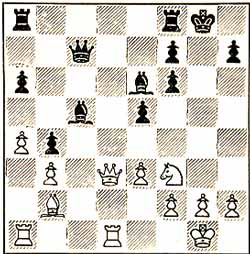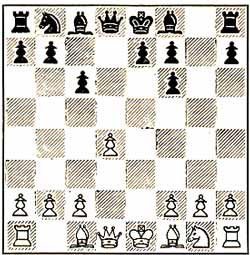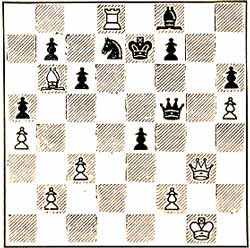|
R A D I O M A T C H R E V I E W E D
|
||
4. MY GAMES WITH FLOHR by I. A. Horowitz CHESS REVIEW DECEMBER 1945 |
After which Black is a helpless victim of a startling combination. The best chance was 17…. Q-K2 when after 18 Kt-R4-B5, Black should be able to pare down to equality. The issue would then be decided on the relative weaknesses on the Q-side.
A bolt from the blue. 18. . . . PxB Anything else losses quickly. 19 Kt-Kt5 K-Kt2 No other move would do: 19…KR-B1; 20 QxPch, K-B1; 21 KtxBch, PxKt; 22 R-Q7 and there is no defense.
20 QxPch K-B3
White not only attacked the Queen, he threatened RxP as well. 25 P-B4! . . . . Which further exposes Black’s King.
25. . . .
RxR This Pawn matters little in the ultimate result.
28 K-R1
KxKt Not 29… QxKP; 30 R-K1, etc.
30 Q-Kt4ch R-B4 31 R-KB1, followed by exchange of major pieces wins by a move. The line chosen is at least as good.
31. . . .
R-B3 32….K-Q4 fails after 33 Q-R8ch, K-Q5; 34 Q-Q8ch, finis. 33 R-B1ch resigns
For if 33…. K-Kt4; 34 P-R4ch wins the rook.
|
|
|
QUEEN'S GAMBIT Salo Flohr
I. A. Horowitz
1 P-Q4
P-Q4
Since in most lines of the Queen's,
Black struggles for freedom with a problem child of a Queen's Bishop on
his hands, I decided on the Gambit Accepted. For the liberation of the QB
is assured - not, however, without incurring some disadvantages. 3 Kt-KB3 . . . . White could recover the Pawn at
once with 3 Q-R4ch. But I had a variation "cooked up" In reply, which for
reasons of state, I cannot divulge at the present time. This brings to
mind similar instances of the past. Pillsbury waited seven long years to
spring a prepared variation against Lasker ; Marshall lured Capablanca
into a baited line.
3 . . . .
Kt-KB3 There is no good way of maintaining the extra Pawn. 5 BxP
P-B4 The Queen’s Bishop is now free to use a commanding diagonal (QR1-KR8X). but the advance is double-edged . For any advance weakens the structure. 9 PxP …. . On 9 B-Q3 (or Kt3), I would have continued with ... P-B5; 10 B-B2, Kt-QKt5, cornering White's valuable KB. Here again, the gain of Bishop for Knight would be offset by disadvantages in Black's Pawn structure. But that is a matter of taste. Personally , I am willing to suffer reasonable inconveniences for such a trade. 9 .
. . . Q-B2 Kt3 is not so good a retreat. For
White's strategy 10 . . . . BxP
|
A plausible continuation Is 10 ... Kt-QKt5, again cornering White's Bishop. But the sharp reply 11 P-QR4 (not the passive 11P-QR3 as given in Modern Chess Openings) leaves Black straining to maintain equality. For instance. 10…Kt-QKt5; 11 P-QR4, KtxB; 12 OxKt, P-Kt5; 13 P-B6 and the BP, immune to capture on account or mate at Q8, exerts a terrific restraining influence on Black’s game. Or in this line 11…. PxP; 12 RxP, BxP; 13 B-Kt5ch, B-Q2; 14 BxBch, KtxB ; White’s pieces are better posted than Black’s and Black’s QRP is a greater weakness than White’s QKtP. 11 P-QR4 . . . . The tactical stroke which collapses Black’s Q-side Pawns. Note that White’s Bishop at Q3 bears down on Black’s Pawns. 11. . . . P-Kt5 11,., PxP; 12 RxP, Kt-QKt5; 13 B-Kt5ch leads to the above noted variation by transposition. Now however, there are other weaknesses in Black's camp. For instance White may anchor a Knight at his QB4 without being molested. 12 QKt-Q2
O-O If 13 Kt-B4 at once, Black could attempt a swap with .. . Kt-QR4, though even after normal development the game is still tenable. 13 . . . . Kt-K4 This is the turning point of the game. I felt that with White’s B-Kt2 in the offing, and his pieces poised for action against my King, sound strategy called for simplification. That is what prompted the text move. However, on subsequent examination, I found that I overrated the attacking chances. For on 13… B—Kt2; 14 B-kt2, Q-K2; 15 Kt-B4 ( 15 QR-B1, Kt-QR4 gives Black a toe hold on White’s weak QKtP) , Black proceeds by placing his Rooks on the Queen and Queen’s Bishop files. Then, the game resolves itself to the exploitation of the weaknesses on the Queen’s wing, where both White’s and Black’s structures need bolstering. 14 Kt-K4! . . . . Banking on a King-side assault, Flohr ignores his chances on the Queen-side. 14. . . . KtxB At last, nabbing the Bishop, but at a price. For Black’s King-side becomes impaired, though I did not rate this as being serious. 15 KtxKtch
PxKt Limiting the scope of White’s Bishop (at Qkt2) and at
the same time creating a square at K3 for Black’s Queen’s Bishop, which
will bear down on White’s QKtP. 17 B-Kt2 . . . . Superficially out of place, but innocently packing a terrific wallop. |
|
|
||
|
1 P-K4 P-QB3 Flohr’s favorite and formerly
preferred by Capablanca. But the popularity of the Caro-Kahn is on the
wane. 2 P-Q4
P-Q4 At this juncture, White has the option of numerous other lines, for instance 3 PxP, PxP; 4 P-QB4, or 3 PxP, PxP; 4 B-KB4, or 3 P-K5. But these alternatives generally lead to highly positional close games, anathema to my natural inclinations. 3 . . . .
PxP 4….B-B4 at once is playable. 5 KtxKtch KtPxKt 5….KPxKt leads to a positional game.
And if Flohr knew how I regarded the subject, he undoubtedly would have
played it. But Flohr had to rely on his experiences in Soviet trial
tournaments and these definitely warned him away from that move. Moreover,
it is true that after 5….KPxKt, White enjoys a Queen-side Pawn majority
which he may exploit.
6 Kt-K2 . . . . Not the book move; I played the text because I did not know the book move. Starting from scratch, I was faced with the problem of finding the move with the greatest prospects. I discounted a move of the King’s Bishop as I wasn’t sure where the Bishop belonged – was it K2, Q3 or QB4? I discarded a move with the Queen’s Bishop as the King-side was crying for development. Hence, the King’s Knight was elected to make the next move. But where to? The natural is Kt-KB3, and while I haven’t checked, I feel sure this is the book move. Yet KB3 seems to be lacking in prospects. For the squares K5 and KKt5 are covered by Black’s Pawn at KB3. Consequently, I hit upon Kt-K2. For at K2, the Knight may go to QB3, KB4 or KKt3, any one of which may be a plausible continuation. 6. . . . B-B4 Black must develop the Queen’s Bishop;
otherwise he violates the spirit of the Caro-Kann. 7 Kt-Kt3 . . . . Immediately utilizing one of the prospective squares for the knight. 7. . . .
B-Kt3 Apparently threatening to win a piece by P-R5. Such , howver, is not the case. For after 8 P-R5 the Bishop might return to B4 and if then 9 KtxB, Q-R4ch gains the Knight. But White will have achieved his objective, the exchange of his Knight for Black’s Bishop. Black guards against this with religious fervor. 8 . . . . P-KR3 Not 8…P-KR4 as after 9 B-K2, Black’s KRP is a fixed target. 9 P-R5
B-R2 As yet, the final square for either of White’s Bishops us not determined. But the center Pawn will require defense sooner or later. So it might as well be defended sooner.
|
An unusual move at this stage of the game, mainly because Black is still underdeveloped. 10…P-K3 or 10…Kt-Q2 seems to be in order. But the change in sequence does not affect the character of the game. In favor of the text move is that it temporarily prevents the development of White’s Queen’s Bishop. 11 B-QB4 . . . . The square for the KB is now determined. B-K2 adds little to White’s prospects; B-Q3, offering a friendly exchange, is in violation of sound strategy: avoid exchanges when intent on attack. By elimination B-QB4 is the move. But it has more than that in its favor. It bears down on Black’s KB2, which is a vulnerable point. 11. . .
. Kt-Q2 Foreboding a general advance on the Queen’s wing to effect a breach on the side destined for the Black King. In addition, it is of psychological importance. For the willingness to advance with abandon on both wings inspires a wholesome awe in an opponent who is particularly cautious by nature. 12 . . . . P-R4 To stop P-R5-6. 13 Q-B3 . . . . To support White’s Knight at K4 or B5. 13. . . .
P-K3 A second unusual move, the point of
which was not properly appreciated by the spectators. Black’s problem is
to find a haven for his King. Obviously this must be on the Queen-side.
Should he castle at once, he risks the consequences of 15 P-Kt4 and the
direct 15 B-B4 . . . . Another possibility is 15 P-Kt3, for the QKtP is apparently immune to capture on account of the pin which would follow. But due to preparation, Black might capture QKtP, allow the pin, and in the ensuing exchanges receive a Rook, Bishop and Pawn for his Queen- almost an equivalent. To boot, this would quash White’s hopes for aggression. 15. . . .
B-Kt6 Completely incomprehensible. As a general rule, and this is a case in point, the underdeveloped side must refrain from opening too many lines. For it stands to reason that they will fall into possession of the adversary. Here, in addition, the text move leaves a ghastly “hole” at Black’s KB4. 17 B-K3
B-Q4 Another thought is 18 Q-K2. For after…Q-B2, White can afford 19 P-QB4, B-K3; 20 P-Q5, PxP; 21 PxP, BxP; 22 KR-B1 and despite the Pawn plus, Black must succumb as he is exposed on both flanks. However, the text move, which suggests an exchange of Bishops, aggravates the hole at Black’s KB4. 18. . . .
Q-Kt6 More or less forcing the following swap. 20. . . .
BxB Obviously not 21….QxKtP; 22 RxKt! With a crushing attack. 22 R-Q2 Kt-B3 If 22….O-O-O ; 23 KR-Q1, B-B4; 24 Kt-B5, BxB; 25 Kt-Q6ch, followed by QxB, leaves White with a sharp attack. 23 Q-B3 KR-Kt1 23 …Kt-Q4 looks better and will succeed in getting rid of White’s dominating Bishop. But it will not solve Black’s problems. For instance, 23 …Kt-Q4; 24 KR-Q1, B-K2; 25 P-B4, KtxB; 26 QxKt and there is no good way of preventing Q-Kt6, which results in a mopping up campaign. 24 KR-Q1 R-Kt5?? An out and out blunder. Against normal play, White continues to make progress. The sacrifice 24…RxKt gave me an uneasy moment. But it would be refuted by 25 QxR, Kt-K5; 26 Q-Kt8, KtxR; 27 RxKt when the treat of B-B5 decides ( if 27…Q-B5; 28 BxP etc.) 25 Kt-B5!! . . . . Superficially impossible and most
likely taking Flohr by surprise on this account. For the move seems to
lose a piece.
|
Forced , for otherwise 26 Kt-Q6ch or 26 R-Q6 decides. And yet it seems to win a piece. 26 B-Kt6! . . . . The saving clause! There is a mate at Q8.
26. . . . RxPch There was nothing else. 26…B-K2 is met by 27 QxR!, KtxQ; 28 Kt-Kt7ch, recovering the Queen! 27 QxR . . . . Not 27 KxR, PxQ check and White can resign. 27. . . . QxKt With a rook for Black’s Knight and a Pawn, white must conclude sharply. 28 R-Q8ch
RxR Threatens mate at Q6. 30. . . . Kt-Q2
31 B-B7 . . . . There is no justice in chess! A fitting conclusion would be 31 RxKtch and it works in all variations but one: eg., 31 RxKtch, QxR; 32 B-B5ch, K-K1; 33 Q-Kt8ch, and White winds up a piece to the good. Or 31 RxKtch, KxR; 32 Q-B7ch, K-K3 (forced); 33 Q-B8ch, K-B3 (or K4), and White had no more than perpetual check. 31. . . . Q-Q4 31… K-B3 is instant death after 32 RxKt, QxR; 33 Q-K5 mate and 31 …K-K3 meets a similar fate by 32 RxB, KtxR; 33 Q-Q6 mate. 32 P-QB4 Q-KKt4 32…. Q-K3 is the unsavory alternative which leaves Black tied in a knot. 33 QxQch PxQ Now Black cannot hope to hope out long. For White’s passed KRP is potent. 34 R-R8 K-K3 34…. B-Kt2 is bad for as soon as White’s Rook crosses over to the King side, the passed RP marches . Nor will 34….P-Kt3 do. Then White is embarrassed by good continuations; eg. 35 B-Q8ch, picking off the Ktp; or more delicately, 35 P-B5! For if 35….PxP; 36 BxP develops a new passed QRP and 35… KtxP; 36 B-Q6ch, KxB; 37 RxB and the KRP advances. 35 BxP P-KB4 Black is continuing on mere momentum.
36 B-B3
P-B5 |
<Sommario>



